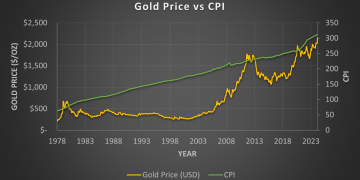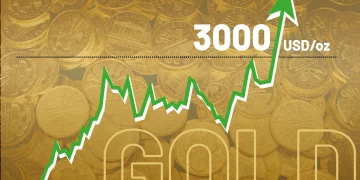Gold has long been regarded as a safe haven and a store of value, especially in times of economic uncertainty. However, like any investment, its price fluctuations present both opportunities and challenges for investors. Understanding the historical trends of gold prices can provide valuable insights into the most effective investment strategies. In this article, we will delve into historical data on gold price trends, examine how past market cycles influence investment approaches, and explore how aligning your strategy with historical performance can guide your investment decisions in gold. We will also analyze the long-term versus short-term gold investment approach, based on historical precedents.
Historical Data on Gold Price Trends and How It Influences Investment Strategies
The price of gold has experienced significant fluctuations throughout history, reflecting a variety of economic, geopolitical, and social factors. From the gold standard era to the modern-day market, gold prices have seen dramatic surges and steep declines. By examining these price movements, investors can gain insight into how different market conditions affect gold prices and how to strategize accordingly.
1. Gold’s Performance During Economic Crises
Gold’s performance during economic crises has cemented its reputation as a reliable store of value. One of the most notable examples of gold’s resilience occurred during the Great Depression in the 1930s. As the global economy faltered, gold prices surged, and it became a safe-haven investment for those looking to protect their wealth.
The same trend was evident during the 2008 financial crisis. As global markets crashed and traditional assets such as stocks and bonds plummeted, gold saw a significant increase in value. Between 2008 and 2012, the price of gold nearly tripled, providing substantial returns for investors who had the foresight to invest in it during uncertain times.
2. Gold’s Performance in Stable Economies
Interestingly, gold also performs well during periods of economic stability, albeit in a more gradual manner. When the global economy is growing, gold’s price tends to rise steadily as demand for the metal increases, both for its use in jewelry and as a hedge against inflation. In stable times, gold often acts as a safeguard against rising living costs and currency devaluation, rather than a sharp speculative asset.
For example, during the early 2000s, as economies around the world expanded, gold experienced slow but consistent growth, with prices climbing from around $250 per ounce in 2001 to over $1,000 by 2008. This period demonstrated that gold is not only a crisis asset but also a long-term store of value in times of growth.
3. Inflation and Gold Prices
Historically, gold has been an excellent hedge against inflation. During times of high inflation, when the purchasing power of fiat currencies diminishes, gold tends to increase in value. The 1970s, for instance, saw a sharp rise in gold prices as inflation in the U.S. soared. Gold prices jumped from around $35 per ounce in 1971 to over $800 per ounce by 1980. Understanding this historical trend is crucial for investors seeking to preserve wealth during inflationary periods.
Tips for Investing in Gold Based on Past Market Cycles
The historical performance of gold provides valuable lessons for investors looking to navigate the complexities of the gold market. By studying past market cycles, you can make more informed decisions about when and how to invest in gold.
1. Invest in Gold During Times of Economic Uncertainty
One of the clearest lessons from history is that gold performs best during times of economic uncertainty. Whether due to geopolitical tensions, stock market crashes, or currency crises, gold often acts as a safe haven during turbulent periods. For example, investors who bought gold during the financial crises of 2008 or the early 1970s made significant returns as the price of gold soared.
To capitalize on this, it is essential to monitor global events and economic trends closely. When signals point to rising geopolitical instability, inflationary pressures, or a potential economic slowdown, it may be an opportune time to increase your exposure to gold.
2. Diversify Gold Investments Across Different Forms
Gold can be invested in various forms, each offering different benefits and risks. Historical data shows that diversifying your gold investments across several channels can help mitigate risk and maximize returns.
- Physical Gold: Coins, bars, and jewelry are tangible assets that provide direct ownership of the metal. However, they also come with storage and insurance costs.
- Gold ETFs and Mutual Funds: These financial products allow investors to gain exposure to gold without having to physically store the metal. They often track the price of gold closely, making them a convenient and liquid option for investors.
- Gold Mining Stocks: Investing in companies that mine gold can provide leverage to the price of gold, as these stocks tend to rise faster than the metal itself during a bull market.
Each of these forms of gold investment has its own advantages and drawbacks, and the best strategy will depend on individual risk tolerance, investment goals, and time horizon.
3. Look for Buying Opportunities During Market Corrections
Another important takeaway from history is the potential for substantial gains during market corrections. Gold, like any asset, goes through periods of volatility. By timing your purchases during price dips or corrections, you can acquire gold at a lower cost and benefit from long-term price appreciation.
For instance, during the 2008 financial crisis, gold’s price temporarily dipped before soaring to record highs. Savvy investors who bought gold during this dip were able to realize substantial returns as the market recovered. Monitoring gold price trends and identifying buying opportunities during corrections can be a valuable strategy for long-term investors.

How to Align Your Gold Investment Strategy with Historical Performance
Aligning your gold investment strategy with historical performance involves understanding the conditions under which gold performs well and adapting your approach to current market conditions.
1. Monitor Key Economic Indicators
By keeping an eye on key economic indicators such as inflation, interest rates, and GDP growth, you can better understand when gold is likely to perform well. For example, when inflation is rising or when central banks lower interest rates, gold prices tend to increase as investors seek safe-haven assets.
Additionally, geopolitical tensions and financial crises can drive up demand for gold. Monitoring these factors can help you anticipate periods of high volatility, enabling you to position your portfolio accordingly.
2. Adopt a Long-Term Investment Mindset
While short-term market fluctuations can present opportunities for traders, history shows that gold is a better long-term investment. The metal has a long history of preserving wealth and has consistently outperformed many other assets over the decades. By adopting a long-term investment mindset, you can ride out short-term volatility and benefit from the sustained growth of gold prices.
3. Rebalance Your Portfolio Based on Market Conditions
Historical data suggests that gold’s performance can vary significantly based on the broader economic environment. Therefore, it is important to regularly review and rebalance your portfolio to ensure that your gold investments are aligned with your overall investment strategy and market conditions.
During times of economic stability, you might consider reducing your exposure to gold in favor of riskier assets like stocks. However, during periods of uncertainty or high inflation, increasing your allocation to gold can help protect your portfolio from market volatility.
Long-Term vs Short-Term Gold Investment: What History Suggests
The question of whether to invest in gold for the long term or the short term depends largely on your investment goals and risk tolerance. Historical data provides insight into how gold behaves over different time frames.
1. Long-Term Gold Investment
Gold has traditionally been a strong performer over the long term, providing a hedge against inflation and acting as a store of value during economic crises. For long-term investors, gold’s ability to preserve wealth over decades makes it an attractive option. Since the 1970s, gold has outperformed many other assets, including stocks, making it a reliable choice for investors seeking to protect their wealth against inflation and currency devaluation.
2. Short-Term Gold Investment
In the short term, gold can be more volatile. While it has the potential for significant gains during periods of economic instability, its price can also fluctuate based on market sentiment and external factors such as interest rates and geopolitical events. Short-term investors may be able to profit from gold’s price swings, but they also face higher risks of losses if they enter the market at the wrong time.
Short-term gold investment is best suited for traders who are comfortable with risk and can capitalize on price volatility. However, for most investors, a long-term approach is likely to yield more stable returns.
Conclusion
Gold has consistently proven to be a valuable asset for investors, particularly during times of economic uncertainty. By analyzing historical data on gold price trends and aligning your investment strategy with past market cycles, you can make informed decisions that maximize your potential returns. Whether you choose a long-term or short-term investment strategy, understanding the historical context of gold’s performance is crucial for navigating its price movements and successfully capitalizing on its investment potential.
As the world moves into 2025, the insights gleaned from historical gold price trends remain highly relevant, guiding investors toward sound investment decisions that reflect both current market conditions and long-term objectives.




































